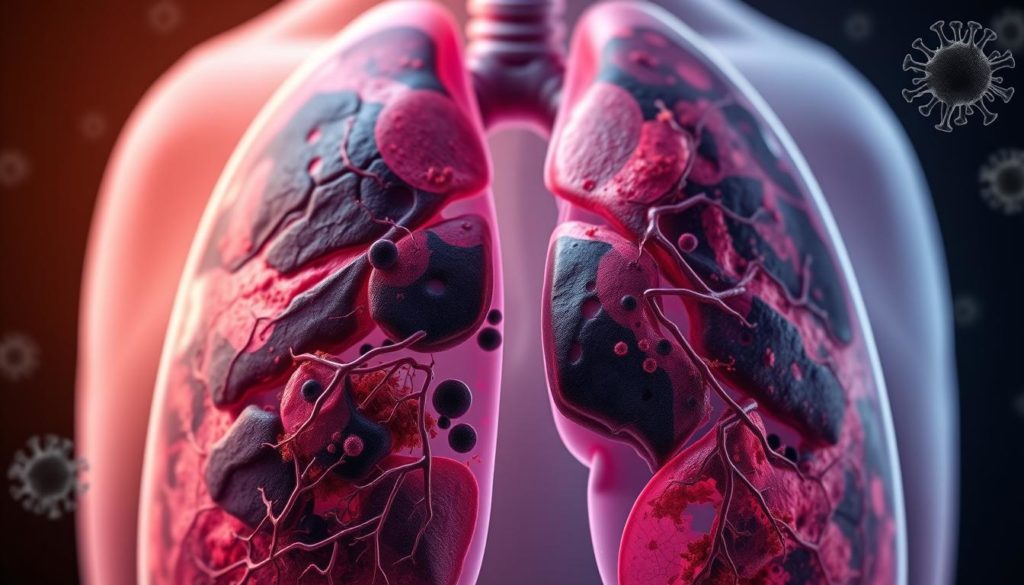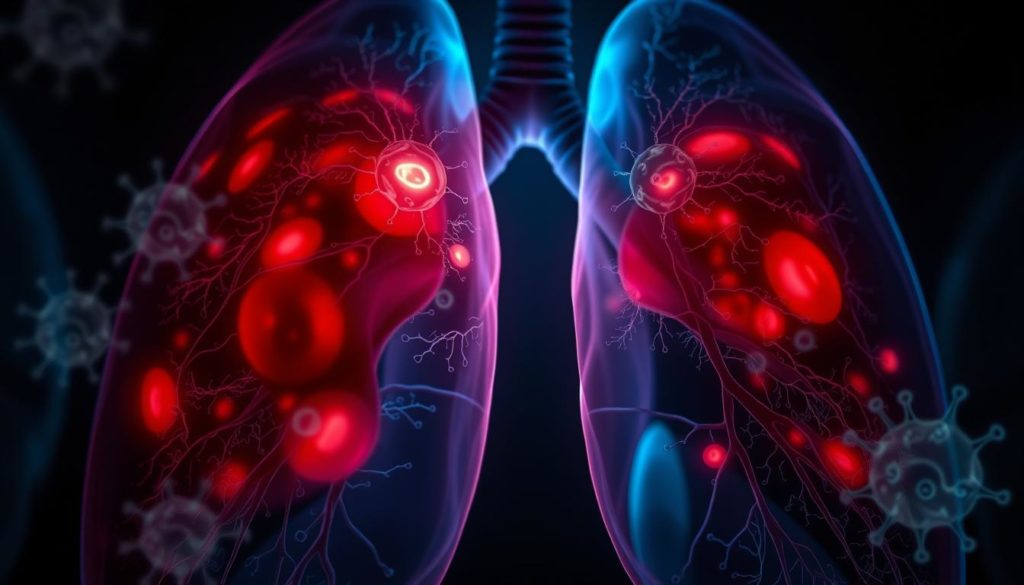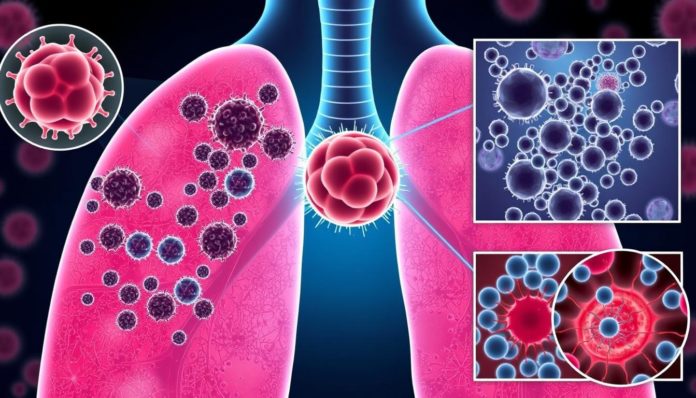Did you know about one-third of deaths from cancer are due to it spreading to the lungs? This fact highlights the need for lung cancer awareness. It shows why spotting the threat of secondary lung cancer early is crucial.
Cancer cells can move from their original location to other body parts, including the lungs, known as metastatic cancer. This condition, especially when it affects the lungs, is very dangerous. It often starts with few signs, making early detection hard but essential. Watch for symptoms like ongoing coughing, feeling out of breath, and losing weight without trying as these may signal late-stage cancer. This situation needs quick medical advice.
Knowing how these harmful cells spread and act is key to finding better treatments for metastatic cancer. Raising awareness about lung cancer helps us deal with this serious condition better. It aims to improve life quality for people dealing with it.
What is Cancer Spreading to Lungs?
Cancer that spreads to the lungs is known as lung metastasis. It starts when cancer cells from another part of the body move to the lungs. This process, called metastasis, uses the blood or lymphatic system to travel.
These cells can form one or several tumors in the lungs. They often appear at the edges or in the lower parts. In the beginning, signs of this metastatic cancer might not show. But over time, clear signs of cancer spreading appear. People might have a constant cough, feel pain in their chest, struggle to breathe, or cough up blood.

Other symptoms can include feeling very tired and losing weight without trying. Knowing how to spot lung metastasis early is key. It helps doctors start treatment sooner.
Common Symptoms of Lung Metastasis
Recognizing lung metastasis early can help start treatment sooner. Symptoms vary but often include a non-stop cough. This cough might even bring up blood, which is a serious sign that needs quick medical help.

Chest pain is another usual symptom, feeling like heaviness inside the chest. People may also find it hard to breathe, especially when doing activities. These signs can disrupt everyday life.
Weight loss without trying is another symptom of lung metastasis. It happens fast and is easy to notice, so seeing a doctor is essential. Also, fluid around the lungs, called pleural effusion, can cause more chest pain and breathing issues.
It’s important to know these symptoms might not just be lung metastasis, but other health problems too. That’s why it’s key to get checked by a doctor. This helps figure out if it’s lung metastasis or something else.
Now, let’s review these symptoms more closely:
| Symptom | Description |
|---|---|
| Continuous Cough | Does not improve, may bring up blood |
| Chest Pain | Possible heaviness or discomfort |
| Shortness of Breath | Difficulty breathing deeply or during exertion |
| Decrease in Appetite | Leading to unexpected weight loss |
| Fluid Accumulation | Known as pleural effusion, causes additional pain and breathing issues |
Diagnosing Cancer Spread to Lungs
Understanding how cancer spreads to the lungs is key to finding the right treatment. This is known as lung metastasis diagnosis. It uses several steps and tools.
Health History and Physical Exam
The first step in diagnostic tests for cancer spread is looking at the patient’s health history and a physical check-up. Doctors look at symptoms, past cancer treatments, family history, and health. This helps them understand the lung metastasis better.
Blood Tests
Clinical tests for lung cancer often include blood tests. These check the patient’s health, how well organs function, and if cancer cells are in the blood. They show if cancer is spreading and if there’s anything unusual that needs more tests.
Imaging Tests
Imaging is important in the diagnostic tests for cancer spread. Common imaging tests are:
- Chest X-rays
- CT scans
- PET scans
- Bronchoscopy
- Lung needle biopsy
These imaging methods help doctors see the lungs and find any cancer or other issues. They give important info that helps plan how to treat the patient. With these diagnostic tests for cancer spread, healthcare providers can accurately diagnose and treat lung metastasis. This ensures patients get the best care available.
Primary Cancers Likely to Spread to the Lungs
Knowing which cancers tend to spread to the lungs is key for early action and care. There are many cancers that may travel to the lungs, both well-known and rare types.
Breast cancer often spreads to the lungs. This is a well-known fact that affects how doctors treat it.
Colorectal cancer can also move to the lungs. For those who’ve had this cancer, staying vigilant is crucial.
Kidney cancer, especially renal cell carcinoma, is prone to spreading to the lungs. Knowing which cancers are likely to spread helps in planning better treatments.
Head and neck cancers, like squamous cell carcinomas, are also likely to reach the lungs. Watching these cancers closely leads to better care and timely treatment.
Other significant cancers include:
- Testicular cancer
- Uterine cancer
- Lymphomas: These often spread to the lungs through the lymph system.
- Bone cancers such as osteosarcoma
- Soft tissue sarcoma
- Melanoma: It’s known for spreading fast, often to the lungs.
- Thyroid cancer
Knowing which cancers are likely to spread to the lungs helps doctors create better care plans. It can greatly improve a patient’s chances by catching the spread early.
| Primary Cancer Type | Cancers Prone to Spreading to Lungs | Metastasis Origin |
|---|---|---|
| Breast Cancer | Yes | Breast |
| Colorectal Cancer | Yes | Colon/Rectum |
| Kidney Cancer | Yes | Kidney |
| Head and Neck Cancer | Yes | Head/Neck |
| Testicular Cancer | Yes | Testes |
| Uterine Cancer | Yes | Uterus |
| Lymphomas | Yes | Lymphatic System |
| Osteosarcoma | Yes | Bones |
| Soft Tissue Sarcoma | Yes | Soft Tissues |
| Melanoma | Yes | Skin |
| Thyroid Cancer | Yes | Thyroid |
Treatment Options for Lung Metastasis
Knowing about lung metastasis treatment options is vital for handling metastatic cancer. The choice of treatment depends on what caused the cancer and how far it has spread.
Here are the methods often used:
- Chemotherapy: Uses drugs to kill or stop cancer cells from growing.
- Immunotherapy: Boosts the immune system to fight cancer better.
- Radiation Therapy: Uses powerful rays to target and kill cancer cells in the lungs.
Surgery could be a choice when there are just a few metastases in the lungs. This is more so if the cancer hasn’t spread elsewhere and the primary cancer is controlled.
Effective metastatic cancer therapy targets both the tumors and symptoms. Managing lung spread can ease major symptoms. Like trouble breathing, by using:
- Opioids for pain relief
- Anti-anxiety medications
- Thoracentesis to remove fluid
- Oxygen therapy to help with breathing
Merging these therapies aims to better the patient’s life while fighting the cancer. This multi-angle strategy is key in caring for lung spread and providing thorough care.
Chemotherapy for Managing Spread to Lungs
Chemotherapy plays a key role in cancer treatment options. It’s particularly useful for those with cancer in the lungs. These powerful medicines circulate in the bloodstream, targeting cancer everywhere in the body. Knowing about chemotherapy helps patients choose wisely about their care.
How Chemotherapy Works
At its core, chemotherapy uses drugs to kill fast-growing cancer cells. These drugs stop cancer from growing by attacking cell division. They interrupt the cell cycle at different stages. Cancer treatment options like these often need many rounds to work best.
Common Chemotherapy Treatments
Chemotherapy for lung cancer might mix drugs like cisplatin, carboplatin, and paclitaxel. Choosing the right plan depends on the cancer’s origin and past treatments. Doctors work to find the best treatments to improve results and make them easier on patients.
Possible Side Effects
Chemotherapy works well but can have adverse effects. Patients might feel sick, get mouth sores, or have trouble in the bathroom. A big concern is bone marrow suppression. This lowers blood cell numbers, leading to tiredness or infection risks. Managing side effects is key for patients’ quality of life during treatment.
Surgical Approaches in Treating Lung Metastasis
Lung metastasis surgery brings hope for cancer spread to the lungs. It works best when the cancer is in one area. Specific cancers sometimes make surgery a good choice. Knowing about the surgery types is key before talking treatments with your doctor.
Types of Surgical Procedures
Doctors remove the sick lung tissue during surgery. The type of surgery depends on where the cancer started and its spread. There are a few main surgeries:
- Wedge Resection: This cuts out a small, wedge-shaped piece of lung with the tumor.
- Lobectomy: This removes an entire lobe of the lung that has the tumor.
- Pneumonectomy: This big operation takes out an entire lung, usually when a lung is badly affected.
When Surgery is Recommended
Doctors suggest surgery based on health, cancer spread, and where the cancer began. Surgery is often advised for certain cancers, like those starting in the colon, bones, or soft tissues, without other metastases. It aims to extend life and keep quality of life high.
Understanding Targeted Therapy
Targeted cancer therapy is a big step forward in cancer treatment. It finds and attacks certain proteins or genes in cancer cells. This stops the cancer from growing and spreading. Targeted therapy is more precise than chemotherapy, so it does less harm to healthy cells.
How Targeted Therapy Works
Targeted therapy works by understanding cancer at a molecular level. Scientists have created drugs like angiogenesis inhibitors, KRAS inhibitors, and more. These drugs block the ways cancer cells grow and spread.
By stopping these paths, targeted therapy can slow down or even stop cancer’s progress.
Who Can Benefit from Targeted Therapy?
Not everyone can use targeted therapy. It works best for those with certain molecular markers. Personalized treatments check these markers with diagnostic tools. This makes sure patients get the most effective treatment.
If you have non-small cell lung cancer, you can find more information here.
Immunotherapy for Lung Metastasis
Immunotherapy is a new hope in cancer fight, especially for lung metastasis. It works by helping our immune system spot and attack cancer cells. Often, it’s used with chemotherapy or radiation, making the treatment more effective.
Who gets immunotherapy depends on the cancer type and the patient’s health. It’s especially promising when other treatments don’t work. By boosting our natural defenses, it stands out in cancer care.
But immunotherapy isn’t without risks. Side effects like flu-like feelings and tiredness can happen. Despite these, its benefits in battling cancer are significant.
Below is a table that compares side effects of various treatments:
| Treatment | Common Side Effects |
|---|---|
| Immunotherapy | Flu-like symptoms, Fatigue |
| Chemotherapy | Hair loss, Nausea |
| Radiation | Skin irritation, Fatigue |
Prevention Methods and Risk Factors
Stopping lung metastasis completely isn’t possible yet. But knowing and handling risk factors can cut down this danger. Keeping lungs healthy and getting regular cancer checks are key ways to prevent it.
Preventing lung metastasis means knowing your personal risks, too. A deep dive into your cancer risk can point out who might get secondary lung cancers. This leads to better care ahead of time.
Sarcoma, renal cell carcinoma, bladder, colon cancer, and melanoma might be stopped early with surgery. So, understanding your cancer risk well is vital to stop metastasis.
- Self-Care and Lifestyle Changes: Quit smoking, eat right, and work out to boost health and lower cancer risk.
- Regular Health Checkups: Get checked often for early signs to boost chances of successful treatment.
- Awareness of Genetic Factors: Family history might raise your risk; genetic advice can tailor prevention for you.
Being alert about lung health and understanding your risks can play a big part. Add good prevention plans, and you greatly reduce lung metastasis chances.
Living with Cancer in the Lungs
Being told you have lung cancer that has spread is tough. But knowing what affects survival can help. The chances of living with this cancer depend on where it started, your health, and when it’s caught. Even though people often talk about a 5-year survival rate, new treatments like immunotherapy are helping patients live longer.
Quality of life is key for lung cancer patients. Small changes can make a big difference. Eating well, staying as active as you can, and taking care of your lungs are important. It’s also vital to take care of your feelings. Joining support groups, talking to a counselor, and sharing with family can offer emotional relief.
Handling lung cancer requires medical care, lifestyle tweaks, and emotional support. Each person’s experience is different, but being up-to-date on treatments can improve life and survival chances. You’re not alone in this fight; there are many groups and people ready to support you through this tough time.
FAQ
What is cancer spreading to the lungs?
Lung metastasis happens when cancer cells move to the lungs from other parts. These cells travel through the blood or lymphatic system. They can create tumors in the lung, often on the edges or in the lower lobes.
What are the common symptoms of lung metastasis?
Key symptoms include a persistent cough and coughing up blood. People may also feel chest pain and shortness of breath. Loss of appetite, weight loss, and regular chest infections are common too. Symptoms may include feeling tired and fluid around the lungs.
How is lung metastasis diagnosed?
Doctors start with reviewing your health history and a physical exam. They use blood tests and imaging tests like chest X-rays and CT scans. Tools like PET scans, bronchoscopy, and biopsies help see cancer’s spread.
Which primary cancers are likely to spread to the lungs?
Cancers like breast, colorectal, and kidney are more likely to spread to the lungs. So are head and neck, testicular, and uterine cancers. Lymphomas, bone cancers like osteosarcoma, soft tissue sarcoma, melanoma, and thyroid cancer also have a high spread risk.
What treatment options are available for lung metastasis?
Treatments include chemotherapy, immunotherapy, and radiation. Surgery is another option. The choice depends on the primary cancer type and how far it’s spread. Managing symptoms is also crucial.
How does chemotherapy work for managing lung metastasis?
Chemotherapy uses drugs to kill cancer cells all over the body. It moves through the bloodstream. The choice of chemotherapy depends on where the cancer started and the patient’s past treatments.
What are the side effects of chemotherapy?
Side effects can include lower bone marrow, nausea, and mouth or bowel problems. These effects are manageable with the right care and support.
When is surgery recommended for lung metastasis?
Surgery is an option when the cancer is just in a small part of the lung and nowhere else. This is often the case with certain cancers like colorectal or soft tissue sarcoma. It is chosen if the original cancer is controlled.
What is targeted therapy for lung metastasis?
Targeted therapy uses drugs to attack cancer cells by focusing on specific proteins. This stops their growth. It’s a personalized treatment, often used with chemotherapy, based on certain markers in the cancer cells.
Who can benefit from immunotherapy for lung metastasis?
Immunotherapy is good for patients with certain cancers who are overall healthy. It helps the immune system fight cancer. It is usually given along with other treatments.
How can lung metastasis be prevented?
Complete prevention isn’t possible, but you can lower risks. Keep your lungs healthy, get regular cancer screenings, and know your risk factors. This may help reduce the chance of cancer spreading.
What is the prognosis for living with metastatic lung cancer?
The outlook depends on several factors like the primary cancer’s source and the patient’s health at diagnosis. Early detection and treatment choice also matter. Life expectancy is around five years on average. However, newer treatments may offer better outcomes and quality of life.


